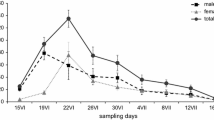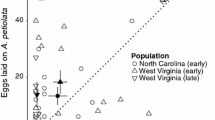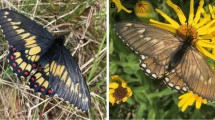Summary
Utilization of patchy habitats by adult populations of threePieris butterflies,P. rapae, P. melete andP. napi was studied throughout the flight season in an area of their coexistence, about 3×1.5 km, in a farm village in the mountains in Inabu, Aichi Prefecture. Field study was by the mark-recapture method. Results were analyzed by dispersal distances and recapture duration decay curves for adults of different age-classes estimated on the basis of physical condition of their wings, together with supplementary information of daliy egg-laying rate of females, obtained in field cages.
Sexually immature, mated femals ofP. rapae after teneral stage showed a migratory flight. On the other hand, reproductive females and all males ofP. rapae were strongly resident within suitable habitats, and reproductive females begun to lay eggs abundantly at sunny places of newly suitable areas within a short period.P. melete seemed to disperse gradually from emerged stites and females of this species continued to lay some constant numbers of eggs for more than ten days over a wider area.P. napi appeared more likeP. melete thanP. rapae.
The habitats of the three species can be characterized as follows:P. rapae, temporary, continued for pre-reproductive females but localized for reproductive females and all males, and unstable;P. melete, permanent, widespread, and stable;P. napi, permanent, localized, and stable.
The numbers of generations ofP. rapae, P. melete andP. napi were estimated to be about six, three and three, respectively. Seasonal fluctuations in the number of adults were influenced by the stability of their habitats, i. e., the population size fluctuated sharply inP. rapae, but it was much more stable inP. melete andP. napi. In view of these results, it can be said thatP. rapae fits the general characteristics of a r-strategist whereasP. melete andP. napi are more K-strategic thanP. rapae.
Similar content being viewed by others
References
Dingle, H. andG. Arora (1973) Experimental studies of migration in bugs of the genusDysdercus.Oecologia 12: 119–140.
Gadgil, M. andW. H. Bossert (1970) Life historical consequences of natural selection.Amer. Natur. 104: 1–24.
Hiura, I. (1968) A history of the genusPieris.Konchu to Shizen. 3 (5): 9–15 (in Japanese)
Johnson, C. G. (1969)Migration and dispersal of insects by flight. Methuen, London, 763 p.
Jolly, G. M. (1965) Explicit estimates from capture-recapture data with both death and immigration-stochastic model.Biometrika 52: 225–247.
MacArthur, R. H. andE. O. Wilson (1967)The theory of island geography. Princeton Univ. Press, Princeton, N. J. 203 p.
Ohsaki, N. (1979) Comparative population studies of threePieris butterflies,P. rapae, P. melete andP. napi, living in the same area. I. Ecological requirements for habitat resources in the adults.Res. Popul. Ecol. 20: 278–296.
Osada, M. andY. Itô (1974) Population dynamics ofPieris rapae crucivora Boisduval (Lepidoptera: Pieridae) an introduced insect pest in Okinawa. I. Winter-spring generations.Jap. J. Appl. Ent. Zool. 18: 65–72. (In Japanese with English summary)
Pianka, E. R. (1970) On r- and K-selection.Amer. Natur. 104: 367–372.
Sato, Y. (1976) Experimental studies on parasitization byApanteles glomeratus L. (Hymenoptera: Braconidae) I. Parasitization to different species of genusPieris.Jap. J. Ent. Zool. 11: 165–175.
Shapiro, A. M. (1970) The role of sexual behavior in density-related dispersal of Pierid butterflies.Amer. Natur. 104: 367–372.
Southwood, T. R. E. (1962) Migration of terrestrial arthropods in relation to habitat.Biol. Rev. 37: 171–214.
Southwood, T. R. E., R. M. May, M. P. Hassell andG. R. Conway (1974) Ecological strategies and population parameters.Amer. Natur. 108: 791–804.
Takata, N. andH. Ishida (1957) Studies on the host preference of babbage butterflies (Pieris rapae L.) II. Preference between cabbage and radish for oviposition.Jap. J. Ecol. 7: 56–58. (In Japanese with English summary)
Takahashi, M. (1975)Pieris napi japonica Shirozr in Shizuoka Prefecture and southern part of Yamanashi Prefecture.Suruga no Konchu 89: 2593–2614. (In Japanese)
Watanabe, S. (1958) An application of the mark and release method to the common cabbage butterfly,Pieris rapae crucivora Boisduval.Jap. J. Appl. Ent. Zool. 2: 232–233. (In Japanese)
Author information
Authors and Affiliations
Rights and permissions
About this article
Cite this article
Ohsaki, N. Comparative population studies of threePieris butterflies,P. rapae, P. melete andP. napi, living in the same area. Res Popul Ecol 22, 163–183 (1980). https://doi.org/10.1007/BF02513543
Issue Date:
DOI: https://doi.org/10.1007/BF02513543




